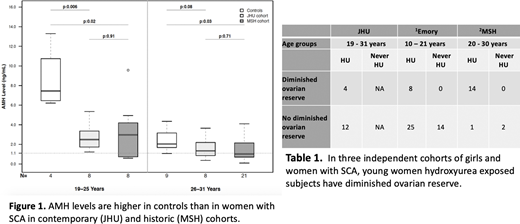Introduction: Females are born with a set number of ovarian follicles. Ovarian reserve, defined by the number of primordial follicles, decreases with age. Diminished ovarian reserve (DOR) is a risk factor for shortened reproductive lifespan, infertility and poor assisted reproductive technology outcomes. Young women with sickle cell anemia (SCA) are at risk for DOR1,2. Whether hydroxyurea (HU) use contributes to this risk is not established. Antimullerian hormone (AMH), a biomarker of the ovarian follicle pool, is used with antral follicle count (AFC) and follicle stimulating hormone (FSH), to estimate ovarian reserve. The extent to which AMH corresponds with visualized AFC in SCA, and thus serves as a reasonable surrogate biomarker, is unknown. The purpose of this study was to test the hypothesis that young women with SCA have lower AMH than age and race matched controls and that HU exposure is a risk for DOR.
Methods: Subjects from our Adult Sickle Cell Center had ovarian reserve measured on day 3-5 of the menstrual cycle or at any time if on menses-suppressing contraception. We measured serum AMH, FSH, estradiol and AFC by ultrasound. Subjects' demographic, reproductive and SCA treatment history were obtained. HU exposure variables included (1) age at first exposure, (2) use at time of study visit, (3) markers of adherence (MCV and ANC), and (4) refill data. Ferritin was used to assess iron overload. We compared AMH levels in subjects ages 19-25 and 26-31 years to AMH levels in age-matched African American women controls with tubal factor infertility and no chemotherapy exposure, and age-matched levels from the historic Multicenter Study of Hydroxyurea (MSH) cohort2. We then compared subject characteristics by the presence of DOR (AMH <1.1ng/mL ± FSH > 10 - 40IU) or primary ovarian insufficiency (POI), (AMH < 1.1ng/mL and FSH ≧ 40IU). The chi-squared and Mann Whitney U test was used for categorical and continuous variables, respectively, to determine associations with DOR.
Results: Sixteen women with SCA participated with a median age of 25.5 years (IQR 21,29), hemoglobin 8.8g/dL (IQR 8,9.2), MCV 96.9fL (IQR 88.6, 101.1), ANC 5.7K/mcl (IQR 3.4, 8.4), and ferritin 857ng/mL (IQR 246, 1957). All had prior HU exposure. The median age at first HU exposure was 17.5 years (IQR 14.5, 21), median months of HU exposure was 23 (IQR 2.8, 38.5). Twelve subjects were taking HU at the study visit and, by refills, 7 took continuous HU in the previous 6-months, median dose 1715mg (IQR 1000, 2000).
Lower AMH and AFC was observed in older subjects as expected. AMH was lower in study subjects compared to controls in both age groups: 19 - 25 years [2.48ng/mL (IQR 1.7, 3.4) vs 7.45ng/mL (IQR 6.5, 10.7), p<.001], 26- 31 years [1.34ng/mL (IQR 0.87,2.2) vs 2.04ng/mL (IQR 1.7,3.2), p=0.08]. The JHU and MSH cohorts had no difference in AMH (p>0.05)1. Younger women (19-25yo) had higher median AFC than older women (26-31yo), a difference that was not statistically significant (14(IQR 8, 35) vs 9(IQR 7,12) follicles).
Four of 16 subjects had DOR; all four were taking HU and >25yo. In those with or without DOR, there was no difference in median BMI (21.1(20.7, 22.4) vs 24.7 (IQR 20.8, 26.2), hemoglobin (8.7 (IQR 8.4, 8.9) vs 8.8 (7.9, 9.8) g/dL), or ferritin (602 (IQR 131, 1529) vs 875 (IQR 303, 1975). DOR was associated with a lower median AFC (5.5(IQR 4, 7) vs 12 (IQR 9,24) oocytes p=0.04) and higher MCV (112 vs 92fL, p=0.02). Table 1 compares DOR and HU exposure our cohort, the MSH2 and a pediatric cohort1. In all cohorts, some young women exposed to HU have DOR.
Conclusions In this pilot study of ovarian reserve in young adult women with SCA, AMH is significantly lower in age- and race-matched controls and levels are similar to an historic SCA cohort. AMH and AFC were both lower in older subjects, suggesting that AMH is a reasonable ovarian reserve marker in SCA. No women had POI. DOR was associated with lower AFC and higher MCV. In young adult women of reproductive age with SCA, taking HU may be a risk for DOR. This data forms the basis for ongoing research on the pathobiological mechanisms and clinical significance of DOR in women with SCA.
References
1Pecker, LH et al. Hydroxycarbamide and ovarian reserve in the Multicenter Study of Hydroxycarbamide. British Journal of Haematology. 2020.
2Elchuri, SV et al. The effects of hydroxyurea and bone marrow transplant on AMH levels in females with SCA. Blood Cells Mol Dis. 2015.
Pecker:Forma Therapeutics: Consultancy. Lanzkron:GBT: Research Funding; HRSA: Research Funding; Ironwood: Research Funding; NHLBI: Research Funding; PCORI: Research Funding; Pfizer: Research Funding; Pharmacy Times Continuing Education: Honoraria; Prolong: Research Funding.
Author notes
Asterisk with author names denotes non-ASH members.


This feature is available to Subscribers Only
Sign In or Create an Account Close Modal